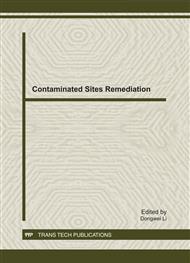p.254
p.262
p.268
p.273
p.280
p.284
p.289
p.294
p.301
Long-Term Phytoremediation Process of Diesel Oil-Contaminated Soil
Abstract:
Soils contaminated with diesel oil were remediated with alfalfa (Medicago sativa) by outdoor pot experiment over a 5-growth season treatment, with pollutant levels, special microbial inoculators, fungi inoculators, and organic manure as control factors. The dynamics of residual concentrations of mineral oil and PAHs in soil of different phytoremediation treatments during the 5 seasons were determined. Results showed that significant reduction of contaminant concentration was achieved. At the end of the fifth growth season, initial concentrations of mineral oil were reduced by 96.5% to 98.8% in the phytoremediat treatments. Among the four factors, bacterial and fungi inoculators showed no significant effect on the contaminant removal in the process of long-term bioremediation. Effect of organic fertilizer amendments differed depending on the diesel concentration. In the highly contaminated treatments (15000 and 30000 mg/kg dry weight) remarkable stimulation was detected with the increase of fertilizer amendment; however, the trend was just reversed in the lightly contaminated treatments (5000 mg/kg dry weight) with the increase of manure amendment.
Info:
Periodical:
Pages:
280-283
Citation:
Online since:
December 2011
Authors:
Keywords:
Price:
Сopyright:
© 2012 Trans Tech Publications Ltd. All Rights Reserved
Share:
Citation:


